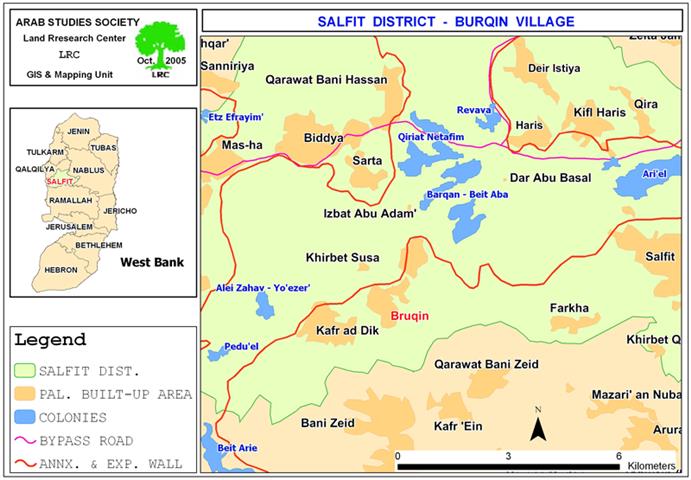Haris village is located 5 km to the northwest of Salfit city and houses a total population of 3800. Its total area is 8450 dunums, out of which, 484 dunums are occupied by the built up area.
The village represents a live example of the severity of the Israeli occupation in regards to land confiscation and property dispossession. During the 1970's, the Israeli Governorate established the Trans-Samaria Highway number 5 over the lands of the village which leaded to the partition of the village into two parts as well as the destruction of hundreds of dunums of fertile agricultural lands and the obstruction of any territorial expansion of the village to the south and to the north. See map 1: Location of Haris village and the surrounding settlements.
In the meanwhile, a number of Israeli settlements besiege the village from three sides and obstruct its expansion; the settlements are: Revava in the west, Qiryat Netafim in the west, Barqan in the southwest and Ariel in the southeast. Continuous daily harassments on part of the Israeli army and settlers are sources of constant fear and tension for the village's citizens.
New land confiscation
At the beginning of this month, the Israeli army circulated a new military order stipulating the confiscation of 400 square meters in Wadi Awad location, basin number 3, for the establishment of a new military observation point (military watch tower) at the junction leading to Yakir settlement in the north of the village. The order carries the number of 321/5729/1969. See photo 1: copy of the new military order.
Impacts of the new Israeli measures
The following are the expected impacts of the establishment of the new Israeli observation point:
1. The planned military tower distances only 60 meters from the residential houses which means that the inhabitants of these houses will live under constant fear and unrest.
2. The expected tower will control the Palestinians movements in and out of the village towards the Trans-Samaria highway and will cut between the western and eastern parts of Salfit Governorate.
3. It will further limit the movement of Palestinian farmers, shepherds and land owners in the areas surrounding the tower.
It is worth mentioning that the owner of the land, Mr. Husni Ali Shamlawi has presented an objection to the Israeli military committee at Beit Eil, but, yet, to no avail.
Prepared by
The Land Research Center
LRC
















